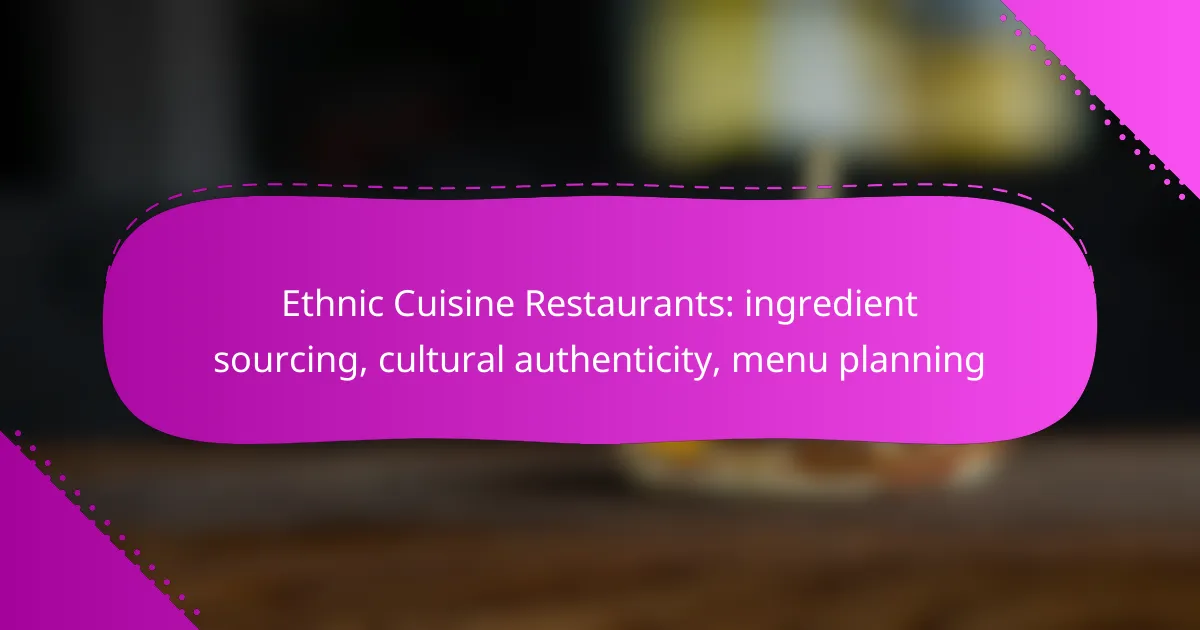Ethnic cuisine restaurants thrive on the delicate balance of sourcing authentic ingredients while honoring cultural traditions. By blending local procurement with international imports, these establishments can maintain the integrity of their dishes. Effective menu planning further enhances this authenticity, ensuring that traditional recipes resonate with contemporary tastes and dietary preferences.

How to source authentic ingredients for ethnic cuisine restaurants in Canada
Sourcing authentic ingredients for ethnic cuisine restaurants in Canada involves a mix of local procurement and international imports. Understanding the cultural significance of each ingredient is crucial for maintaining authenticity while meeting customer expectations.
Local suppliers for ethnic spices
Finding local suppliers for ethnic spices can enhance the authenticity of your dishes while supporting the community. Look for specialty grocery stores or farmers’ markets that cater to specific cultural communities, as they often stock unique spices.
Consider establishing relationships with local spice vendors who can provide fresh, high-quality products. Regularly visiting these suppliers can help you stay updated on seasonal offerings and new arrivals.
Importing specialty ingredients
Importing specialty ingredients is essential for dishes that require items not commonly found in Canada. Research reputable importers who specialize in ethnic foods and can provide a consistent supply of authentic ingredients.
Be mindful of import regulations and customs duties, which can affect your costs. Establishing a reliable shipping schedule can help ensure that your ingredients arrive fresh and on time, minimizing disruptions to your menu.
Partnerships with cultural organizations
Partnering with cultural organizations can provide valuable insights into ingredient sourcing and menu development. These organizations often have connections to suppliers and can help you navigate the complexities of sourcing authentic ingredients.
Engaging with cultural communities can also enhance your restaurant’s credibility and attract a loyal customer base. Consider hosting events or workshops that celebrate the culture behind your cuisine, fostering a deeper connection with your audience.

What are the key factors for cultural authenticity in ethnic cuisine?
Cultural authenticity in ethnic cuisine hinges on several key factors, including the use of traditional cooking methods, incorporation of regional recipes, and engagement with cultural consultants. These elements ensure that the food not only reflects the heritage of its origin but also resonates with the community it represents.
Use of traditional cooking methods
Traditional cooking methods are essential for maintaining the authenticity of ethnic cuisine. Techniques such as slow cooking, grilling over open flames, or fermenting can significantly influence the flavor and texture of dishes. For instance, using a tandoor oven for Indian naan or a clay pot for Moroccan tagine can enhance the dish’s authenticity.
When planning a menu, consider how these methods can be integrated. Investing in the right equipment and training staff in traditional techniques can elevate the dining experience and connect patrons to the culture behind the cuisine.
Incorporating regional recipes
Incorporating regional recipes is crucial for achieving cultural authenticity. Each region often has its unique ingredients and preparation methods that define its culinary identity. For example, using local spices and herbs in Thai dishes or specific types of pasta in Italian cuisine can create a genuine taste experience.
To ensure authenticity, research and source recipes from reputable sources or local chefs. This not only enriches the menu but also honors the culinary traditions of the region, making the dining experience more immersive for guests.
Engaging with cultural consultants
Engaging with cultural consultants can greatly enhance the authenticity of an ethnic restaurant. These experts can provide insights into traditional practices, ingredient sourcing, and cultural significance of various dishes. Their knowledge can help avoid common pitfalls and ensure that the cuisine is represented accurately.
Consider collaborating with chefs from the culture being represented or hiring consultants who specialize in that cuisine. This partnership can lead to a more authentic menu and a deeper understanding of the cultural nuances that influence the food.

How to effectively plan a menu for ethnic cuisine restaurants
Effective menu planning for ethnic cuisine restaurants involves a careful balance of authenticity, seasonal ingredients, and customer preferences. A well-structured menu not only showcases traditional dishes but also adapts to modern tastes and dietary needs.
Seasonal ingredient considerations
Incorporating seasonal ingredients is crucial for enhancing the flavor and authenticity of ethnic dishes. Sourcing local produce during peak seasons can improve freshness and reduce costs. For example, using summer vegetables in Mediterranean dishes or root vegetables in winter can create a more vibrant menu.
Consider establishing relationships with local farmers or markets to ensure a steady supply of high-quality ingredients. This not only supports the community but can also help in crafting unique dishes that reflect the local terroir.
Balancing traditional and modern dishes
Striking a balance between traditional and modern dishes is essential for appealing to a broader audience. While traditional recipes should remain at the core of the menu, incorporating modern cooking techniques or fusion elements can attract adventurous diners. For instance, offering a classic curry alongside a curry-infused risotto can cater to diverse tastes.
Be mindful of maintaining the integrity of traditional dishes to avoid alienating purists. Small adjustments, such as offering gluten-free options or lighter versions, can modernize the menu without compromising authenticity.
Customer preferences and dietary restrictions
Understanding customer preferences and dietary restrictions is vital for menu planning. Many diners today seek options that accommodate various dietary needs, such as vegetarian, vegan, or gluten-free choices. Including a few well-crafted options can enhance customer satisfaction and broaden your clientele.
Regularly soliciting feedback from customers can help identify popular dishes and potential gaps in your offerings. Consider creating a separate section on the menu for dietary-specific options to make it easier for customers to find what suits their needs.

What are the best practices for marketing ethnic cuisine restaurants in Canada?
Effective marketing for ethnic cuisine restaurants in Canada involves leveraging digital platforms, sharing cultural narratives, and engaging with influencers. These strategies help build a strong brand identity and attract a diverse clientele interested in authentic dining experiences.
Utilizing social media platforms
Social media is essential for promoting ethnic cuisine restaurants, as it allows for direct engagement with potential customers. Platforms like Instagram and Facebook can showcase vibrant dishes and cultural events, attracting food lovers and curious diners alike.
Posting high-quality images, behind-the-scenes videos, and customer testimonials can enhance visibility. Consider using targeted ads to reach specific demographics interested in ethnic foods, which can increase foot traffic and online orders.
Highlighting cultural stories
Sharing the cultural stories behind your dishes can create a deeper connection with customers. This includes explaining the origins of recipes, the significance of ingredients, and personal anecdotes from the chef or family traditions.
Incorporating storytelling into your marketing can be done through blog posts, social media captions, or even menu descriptions. This approach not only educates diners but also fosters appreciation for the cuisine’s authenticity and heritage.
Collaborating with food influencers
Partnering with food influencers can significantly boost your restaurant’s visibility. Influencers with a passion for ethnic cuisine can create authentic content that showcases your dishes to their followers, expanding your reach.
When selecting influencers, look for those whose audience aligns with your target market. Offering complimentary meals in exchange for reviews or social media posts can be an effective strategy, but ensure that the influencer’s style matches your restaurant’s brand for genuine representation.

How to evaluate the success of an ethnic cuisine restaurant?
Evaluating the success of an ethnic cuisine restaurant involves assessing customer satisfaction, financial performance, and community involvement. These factors provide insight into the restaurant’s authenticity, quality, and overall impact on its local market.
Customer feedback and reviews
Customer feedback is crucial for understanding how well an ethnic cuisine restaurant meets its patrons’ expectations. Online reviews on platforms like Yelp or Google can reveal trends in customer satisfaction, highlighting popular dishes and areas needing improvement.
Consider conducting regular surveys to gather direct feedback from diners. Aim for a balanced approach, encouraging both positive and constructive criticism to enhance the dining experience.
Sales performance analysis
Sales performance analysis involves tracking revenue trends, average transaction values, and customer volume over time. Monitoring these metrics helps identify peak dining times and popular menu items, which can inform inventory and staffing decisions.
Establish benchmarks for sales growth, aiming for steady increases in revenue. Comparing performance against similar restaurants in the area can also provide context for your results.
Community engagement metrics
Community engagement metrics assess how well an ethnic cuisine restaurant connects with its local audience. This can include participation in cultural events, collaborations with local organizations, and social media engagement.
Track metrics such as event attendance, social media interactions, and partnerships with local businesses. This information can help gauge the restaurant’s reputation and influence within the community, contributing to long-term success.

What are the emerging trends in ethnic cuisine restaurants?
Emerging trends in ethnic cuisine restaurants focus on authenticity, sustainability, and innovative menu offerings. Chefs are increasingly sourcing ingredients directly from local farmers or international suppliers to maintain cultural integrity while adapting to modern dietary preferences.
Ingredient sourcing
Ingredient sourcing is crucial for ethnic cuisine restaurants to ensure authenticity and quality. Many establishments are now prioritizing local and organic produce, which not only supports the community but also enhances flavor. Sourcing ingredients from specialty suppliers who import traditional items can help maintain the cultural essence of the dishes.
Restaurants often establish relationships with farmers and suppliers to secure fresh, high-quality ingredients. This can include visiting local markets or participating in community-supported agriculture (CSA) programs. Additionally, some chefs are experimenting with fusion ingredients that complement traditional recipes while appealing to contemporary tastes.
Cultural authenticity
Cultural authenticity is a key focus for ethnic cuisine restaurants, as diners increasingly seek genuine culinary experiences. This involves not only using traditional recipes but also understanding the cultural significance behind the dishes. Chefs may engage with cultural consultants or community members to ensure that their interpretations respect the origins of the cuisine.
Maintaining authenticity can also extend to the restaurant’s ambiance and service style, reflecting the culture’s traditions. For example, a Mexican restaurant might incorporate traditional music and decor, while a Thai restaurant could emphasize family-style dining. This holistic approach enhances the overall dining experience and fosters a deeper connection to the cuisine.
Menu planning
Effective menu planning is essential for ethnic cuisine restaurants to balance authenticity with customer preferences. Chefs should consider seasonal ingredients and local tastes while ensuring that traditional dishes remain central to the menu. Offering a mix of classic items and modern interpretations can attract a wider audience.
It’s beneficial to regularly update the menu based on customer feedback and seasonal availability. Restaurants might introduce limited-time offerings or themed nights to keep the dining experience fresh and engaging. Additionally, clear labeling of dishes that cater to dietary restrictions, such as vegan or gluten-free options, can broaden appeal without compromising authenticity.
